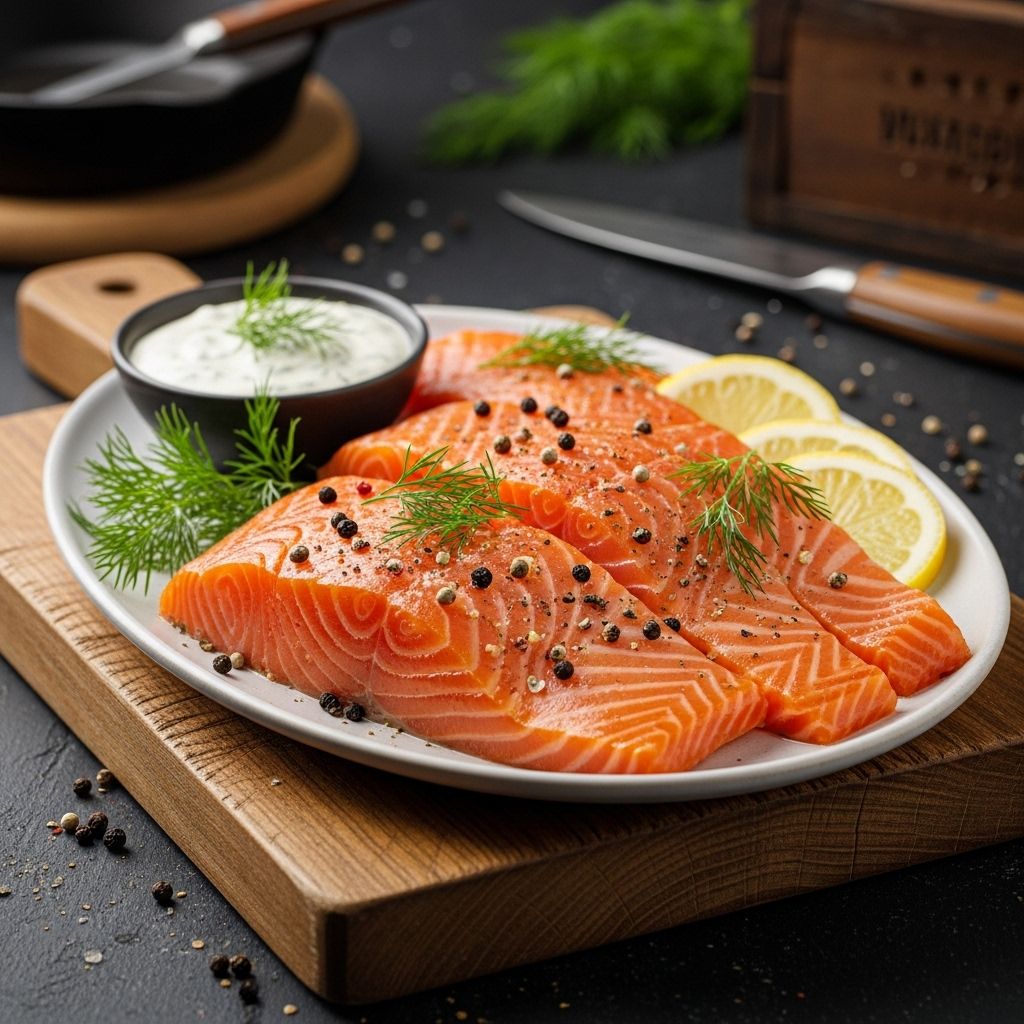How to Smoke Salmon at Home: A Step-by-Step Guide
Unlock restaurant-level taste with tailor-made seasonings and foolproof curing techniques.

How to Smoke Salmon at Home: A Comprehensive Guide
Smoked salmon is a delicacy renowned for its nuanced flavor, silky texture, and versatility in both simple and gourmet dishes. Making smoked salmon at home not only results in fresher, more customizable flavor but also gives greater control over the final outcome than store-bought alternatives. In this in-depth guide, you’ll learn the entire process from fish selection to slicing, along with essential science and tested tips to achieve exceptional results every time.
Why Make Smoked Salmon at Home?
Homemade smoked salmon offers several advantages:
- Superior freshness: Choose high-quality, fresh fish for the best base flavor and texture.
- Custom flavors: Adjust spices, smoke intensity, and sweetness to your taste.
- Cost-effective: Substantial savings compared to premium store-bought options.
- No preservatives: Avoid additives common in commercial products.
The Smoking Process: Overview
Smoking salmon involves several key steps:
- Choosing and preparing the salmon
- Brining
- Rinsing and drying
- Smoking
- Slicing and serving
What Is Smoked Salmon?
Smoked salmon is salmon fillet that has been cured (through brining or salting) and then exposed to smoke from burning wood. There are two main styles:
- Cold-Smoked: Cured and smoked at a low temperature (around 80°F/27°C or lower). Results in a soft, silky, almost raw-like texture—often found with lox.
- Hot-Smoked: Cured and then smoked at a higher temperature (120–180°F/49–82°C or higher), giving a flaky, cooked texture. The method outlined here is hot smoking, which is the most accessible for home cooks.
Essential Equipment
- Smoker: An electric, charcoal, pellet, or propane smoker works well. Kettle grills can also be adapted for smoking.
- Thermometer: A digital probe thermometer ensures the proper internal temperature.
- Wire racks and trays: For air drying and transporting the fish.
- Sharp knife: For clean, even slicing.
Choosing Your Salmon
The foundation of good smoked salmon is the quality and cut of fish:
- Type: Any species—King (Chinook), Sockeye, Coho, or Atlantic salmon—can be used. Wild-caught varieties tend to have richer flavor and firmer flesh. Look for bright color and no off-odors.
- Fillet vs. Side: Full sides or center-cut fillets, skin-on, work best for even smoking and slicing.
- Boneless: Remove any pin bones with pliers for easy slicing post-smoking.
Step 1: Brining the Salmon
Brining draws out excess moisture, seasons the fish, and helps develop the characteristic texture and flavor of smoked salmon.
Why Brine?
- Improves flavor and enhances juiciness
- Promotes a firmer, sliceable texture
- Prevents the flesh from drying out during smoking
Types of Brines
- Dry Brine: A mix of salt, sugar, and optional seasonings (like black pepper, citrus zest, herbs, or spices) directly rubbed on the fish. More traditional for hot-smoked salmon.
- Wet Brine: Salt and sugar dissolved in water; the fish is immersed for several hours. Useful for large or thicker cuts.
Basic Dry Brine Ratio: For each pound (450g) of salmon, use approximately:
- 2 tablespoons kosher salt
- 2 tablespoons brown sugar (or white sugar for a cleaner taste)
Brining Instructions
- Mix salt, sugar, and optional spices together.
- Spread a thin layer of the mixture in a shallow dish. Lay the salmon skin-side down.
- Cover generously with more brine mixture.
- Cover with plastic wrap and refrigerate for 4–8 hours (for fillets) or up to 12 hours (for full sides).
Step 2: Rinsing and Drying (Pellicle Formation)
After brining, rinse the salmon under cold water to remove excess salt and sugar, which can overpower the final taste if left on. Gently pat dry with paper towels.
The next crucial step is drying the fish until it develops a slightly tacky surface, called the pellicle. This allows smoke to adhere uniformly, ensuring better flavor and color.
- Place rinsed salmon on a wire rack over a tray in a cool, well-ventilated spot or in the fridge (uncovered)
- Let dry for 2–4 hours, or longer if possible
The appearance should shift from slick and wet to matte and slightly sticky.
Step 3: Smoking the Salmon
With the salmon brined and dried, it’s ready for smoking! The right wood and temperature are crucial for the final taste and texture.
Choosing Wood
- Mild woods like alder and apple impart classic, subtle smoke.
- Cherry provides gentle sweetness.
- Hickory and mesquite are best used in small quantities due to their strong flavors.
Setting Up Your Smoker
- Preheat your smoker to 150–180°F (65–82°C). Electric smokers make temperature control easier, but charcoal and pellet types work well with proper monitoring.
- Add your preferred wood chips or chunks. Place a drip tray with water beneath the grates to stabilize humidity.
- Arrange the salmon skin-side down on the grates or racks, spacing each fillet so smoke can circulate evenly.
Smoking Time and Target Temperature
- Smoke until the thickest part of the salmon reaches 135–140°F (57–60°C). This typically takes 1–3 hours, depending on your smoker, the thickness of the fish, and external conditions.
- For a gentler, moister texture, aim for the lower end of the temperature range; for a flakier, more “cooked” result, aim higher.
Step 4: Cooling and Storing
- Remove the smoked salmon from the smoker and let it cool at room temperature for 30–60 minutes.
- Wrap tightly in plastic wrap, foil, or use a vacuum sealer. Refrigerate for up to one week or freeze for longer storage (up to 2–3 months).
- Resting overnight before slicing deepens the flavor and results in a firmer texture.
Step 5: Slicing and Serving
Smoked salmon can be sliced thinly on a bias for classic presentation or cut into thicker pieces for more rustic serving.
- Use a long, sharp blade.
- Angle the knife for the thinnest, smoothest slices, cutting across the grain for tenderness.
Classic serving ideas include bagels with cream cheese, rye bread with fresh herbs, eggs, salads, and canapés. Smoked salmon also adds depth to pasta, quiche, and grain bowls.
Tips for Success
- Patience during pellicle formation ensures optimal smoke adhesion and flavor.
- Monitor smoker temperature closely; fluctuations can lead to uneven texture.
- Avoid over-smoking—too much time or smoke creates bitterness.
- Experiment with spice blends, citrus zest, or maple syrup for custom flavors in your brine.
- Always use food-safe methods and fresh, high-quality fish for safety and best results.
Common Variations
- Maple or honey-brined salmon for a sweet-savory balance.
- Spicy brines using chili flakes, cayenne, or black pepper.
- Herb-brined salmon adds brightness with dill, thyme, or tarragon.
Frequently Asked Questions (FAQ)
Q: Can I use frozen salmon for smoking?
A: Yes. Thaw the salmon fully in the refrigerator before starting the brining process for the best texture and flavor.
Q: How long will homemade smoked salmon last?
A: Properly wrapped and refrigerated, smoked salmon lasts up to 1 week. For longer storage, freeze in portions for up to 2–3 months. Consume soon after thawing for peak quality.
Q: Is it safe to eat hot-smoked salmon without further cooking?
A: Yes. Hot smoking fully cooks the salmon to a safe temperature; it is ready to eat once cooled.
Q: Can I make smoked salmon without a dedicated smoker?
A: Absolutely. A kettle grill can be adapted for indirect heat and smoke, or use a stovetop smoker indoors. Maintain low temperatures for optimal results.
Safety Tips and Final Advice
- Always keep raw fish refrigerated until use.
- Observe food safety when handling brined seafood.
- Use a thermometer to avoid undercooking.
- Label homemade smoked salmon with a preparation date.
Table: Quick Reference for Hot-Smoked Salmon
| Step | Time | Key Details |
|---|---|---|
| Brining | 4–12 hours | Dry brine (salt, sugar); chill in fridge |
| Drying (Pellicle) | 2–4 hours | Open air on rack until tacky surface develops |
| Smoking | 1–3 hours | 150–180°F (65–82°C); target salmon temp 135–140°F (57–60°C) |
| Resting | Overnight (recommended) | Wrap and refrigerate for enhanced flavor/texture |
Key Takeaways
- Quality fish and patience at each step produce the most flavorful results.
- Brining, drying for pellicle, and careful temperature control are crucial.
- Homemade smoked salmon is versatile, delicious, and rewarding to prepare.
Read full bio of Srija Burman












